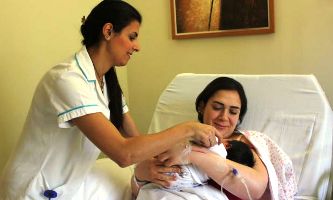 Every mother and child counts
Every mother and child counts
Lebanon has witnessed significant improvement in reproductive health outcomes and indicators as clearly demonstrated in the results and findings of the Pan Arab Survey for Family Health (PAPFAM) conducted in 2004. Particular progress has been seen in reaching the target of Millennium Development Goal 5, namely improving maternal health, particularly reducing the maternal mortality ratio.
A recently conducted hospital-based reproductive age mortality survey showed a maternal mortality ratio of 23 maternal deaths per 100 000 live births, and WHO has acknowledged and endorsed this figure with a minor correction for underestimation of early pregnancy related maternal death (the WHO figure is 26). The PAPFAM survey has also indicated that 95.5% of pregnant women received prenatal care, however this proportion varies regionally. Antenatal care is found to be proportional to education level and inversely proportional to number of children.
PAPFAM data indicate that 92% of all births take place in hospitals (private and public) and only 2.4% of births are still taking place at home. Interestingly, the survey showed that 83.7% of women who did not seek postnatal care claimed that such care was not a felt need, as they did not suffer from any complications and/or side effects as a result of giving birth. In terms of family planning, the PAPFAM survey indicates that the proportion of 15-24 year-old females who ever used any method of contraception is higher among older women, reaching 73.5% and 76.2% among the age groups 25-34 and 35-49 years respectively, as compared to only 43.6% (dropping to 28.7% for use of modern contraceptives) for the age group 15-24 years. The data show that oral contraceptives are the most frequently used method (35.1%) followed by the intrauterine device (29.3%), whereas condom use is still quite low at only 10.7%. Data on adolescent pregnancy are still not available. A survey on knowledge, attitudes, behaviour and practices was conducted and results disseminated in 2012.
Child health
Lebanon has made significant efforts toward reaching the target of Millennium Development Goal 4, namely reducing child mortality. Despite the progress, the infant and child mortality rates are average for the Region, with the infant mortality rate at 9 per 1000 live births and under-five mortality rate of 10 per 1000 live births in 2009, noting that Lebanon does have an established child mortality surveillance system.
Great efforts have been made to improve vaccination coverage, particularly over the past two decades; however, the current vaccine-preventable disease patterns and trends in Lebanon still reflect suboptimal immunization coverage. In fact, the immunization coverage may even be on the decline, compared to one decade ago.
In response to the 2013 positive environmental samples and the outbreak of polio cases in Syria, WHO and the neighbouring countries declared a polio emergency. According to the UNHCR, there are over 900 000 registered Syrian refugees in Lebanon and around 50 000 awaiting registration, with an additional 90 000 Palestinian refugees from the Syrian Arab Republic. Due to the government’s no-camp policy, Syrian refugees are spread over 1400 localities, many in informal settlements and collective shelters. To address this situation, the Lebanese Ministry of Public Health has reinforced its routine vaccination programme through the reach every child approach. In response to the outbreak, mandatory polio vaccination is being provided to children aged under 5 years arriving at the four official border crossings. Ongoing immunization activities are also taking place at the five UNHCR registration centres, giving measles plus polio vaccinations in addition to vitamin A supplements.
Lebanon is taking all steps necessary in order to maintain its certification as polio-free since 2002. Measles remains a major public health concern, with one of the highest reported incidences among the countries in the Region.
WHO national programme
The national child perinatal and neonatal network was established a decade ago and is being maintained with the support of WHO. It has progressively expanded to include currently 35 hospitals across the country covering around 33% of all deliveries. Efforts will focus on exploring possibilities for expanding network capacity to obtain data on maternal mortality and morbidity.
Neonatal resuscitation training was initiated with the support of WHO in 2008, in collaboration with a local and an international specialized nongovernmental organization. It was adopted by the Ministry of Public Health to certify health staff working in emergency paediatrics units and delivery rooms in emergency resuscitation of neonates, with the ultimate goal of reducing child mortality and morbidity attributed to neonatal prematurity and appropriateness of care.
In the context of the safe motherhood initiative, training on emergency obstetrical care was initiated and implemented by WHO in collaboration with UNFPA and the Ministry of Public Health. It provided training to around 1000 staff working in hospital emergency rooms and at the level of primary health care on principles and guidelines for management of reproductive health in emergencies. Efforts will focus on integrating this training as part of university curricula as well as part of primary health care capacity-building.
WHO has initiated discussions with the Ministry of Public Health and concerned stakeholders to develop options that will allow improved data and information regarding maternal mortality and morbidity.
Efforts will focus on improving maternal and child data, as well as further developing the piloted interventions and enhancing private sector cooperation in these two areas.
Related links
Making Pregnancy Safer indicators


